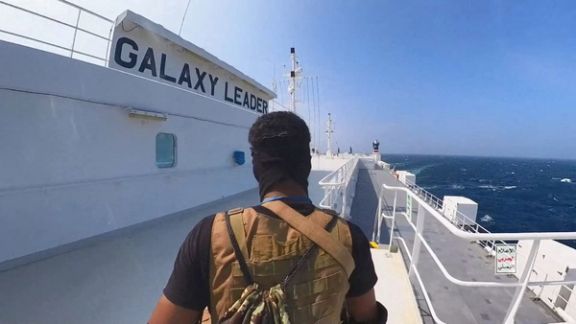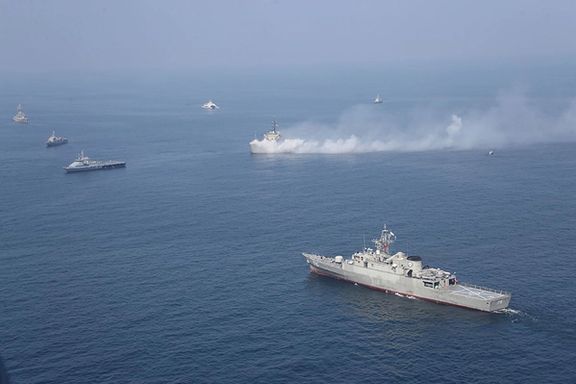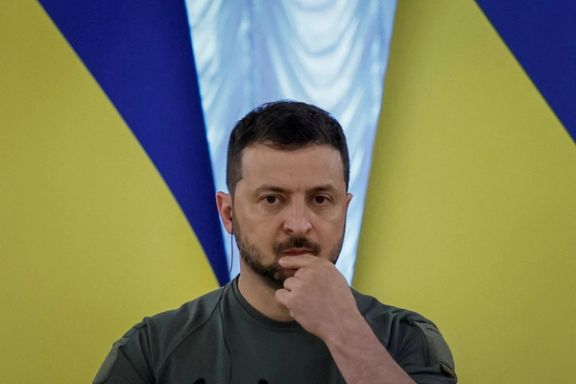Hezbollah Says Attacks On Israel Will Stop When Gaza War Ends

The leader of Iran-backed Hezbollah in Lebanon said on Tuesday that his group's cross-border shelling into Israel would only end when Israel's "aggression" on the Gaza Strip stops.

The leader of Iran-backed Hezbollah in Lebanon said on Tuesday that his group's cross-border shelling into Israel would only end when Israel's "aggression" on the Gaza Strip stops.
Hassan Nasrallah claimed that diplomatic efforts so far to bring a halt to hostilities along Lebanon's border seemed to only benefit Israel.
Hezbollah has been trading fire with the Israeli military across Lebanon's southern border in support of its Palestinian ally Hamas, since war started on October 7 that was met with heavy Israeli bombardment by land, air and sea.
Nasrallah said his group would only stop its exchanges of fire if a full ceasefire was reached for Gaza.
"On that day, when the shooting stops in Gaza, we will stop the shooting in the south," he said in a televised address.
He said many foreign "delegations" had travelled to Beirut with "proposals" to end hostilities in southern Lebanon, but said they only seemed to "have one goal, which is: the security of Israel, the protection of Israel."
The foreign ministers of France, Britain, and other countries have travelled to Lebanon in recent weeks to bring calm to the border.
France's foreign minister delivered a written proposal to Beirut that calls for Hezbollah's units to withdraw 10 km (6 miles) from the border.
"You read the paper - there's nothing. There's Israel's security," he said.
The cross-border shelling has already killed around 200 people in Lebanon, including more than 170 Hezbollah fighters, as well as 10 Israeli troops and five Israeli civilians. It has also displaced tens of thousands of people in each country.
Nasrallah said residents of northern Israel "will not return" to their homes and threatened that even more would be displaced.

A State Department spokesman told Iran International that the Tehran-backed Houthis' Red Sea blockade not only threatens global food supplies but "now directly threatens even Iran’s own supply of food."
It follows an attack on a bulk carrier of corn traveling from Brazil to Iran on Monday. "This is just the latest, absurd example demonstrating that the Iranian regime supports terrorism and destabilizing behavior by groups like the Houthis at the expense of all the people of the region, including the Iranian people themselves," the spokesperson said.
Citing maritime sources, Reuters reported that the attack was the first time a ship headed for Iran was targeted amidst the Red Sea blockade, launched in November.
A regional security official told Reuters that the attack appeared designed to "show Iran does not control the Houthis and they act independently." They added that the Houthis had informed Tehran in advance, though so far Iranian officials are yet to comment on the allegations or the attack itself.
The Yemeni Houthis joined the proxy war which emerged in the aftermath of Iran-backed Hamas's attack on Israel on October 7. The deadliest day for Jews since the Holocaust, Hamas killed 1,200 mostly civilians and took at least 250 more hostage. Israel's relentless retaliation on the Gaza based militia has led to large swathes of the strip destroyed and around two thirds of the population at least displaced.
In solidarity, Iranian proxies in Iraq, Lebanon, Syria and Yemen have attacked both Israel and US targets, punishment for Biden's support of Israel's right to defend itself in the wake of the October atrocities.

Rafael Grossi, the Director-General of the UN nuclear watchdog said Iran is “not entirely transparent," following worrying remarks by Iran's former nuclear chief, Ali Akbar Salehi.
In a televised interview, Salehi, who was also foreign minister (2010-2013), was asked if Iran has achieved the capability of developing a nuclear bomb. Avoiding a direct answer he stated, "We have [crossed] all the thresholds of nuclear science and technology."
Grossi addressed Salehi's warnings directly on Tuesday at Dubai’s World Government Summit. “There’s loose talk about nuclear weapons more and more, including in Iran recently. A very high official said, in fact, we have everything, it’s disassembled. Well, please let me know what you have,” he said.
To say that Iran is “presenting a face which is not entirely transparent when it comes to its nuclear activities”, as Grossi called it, will come as no surprise to the international community as Iran has repeatedly obstructed inspectors of the IAEA in their work to assess Iran’s nuclear enrichment.
In October, Iran branded IAEA inspectors political "extremists" as it tried to justify its standing in the way of vital work.
The head of the Atomic Energy Organization of Iran (AEOI), Mohammad Eslami, justified Tehran's decision to ban what Grossi said was around one third of the international inspection team, claiming those expelled had a history of "extremist political behavior”.
At the time, Eslami downplayed the scale of the ban, saying instead that it was an "insignificant" number expelled, contradicting the statement by Grossi in which he made a rare public criticism of the regime for its obstructive behavior in September.
An exasperated Grossi said in September: “With today’s decision, Iran has effectively removed about one third of the core group of the Agency’s most experienced inspectors designated for Iran,” adding that the move "affects in a direct and severe way the ability of the IAEA to effectively conduct its inspections in Iran.”
Just days ago, weapons expert David Albright told Iran International: “The transparency of the nuclear program has decreased significantly. Their [Iran’s] nuclear weapons capabilities have grown over the last several years … And it's also a point in time where people's attention is elsewhere. The Iran nuclear issue barely makes the newspapers these days.”
Amid a regional proxy-war led by Iran’s militias around the Middle East, the nuclear issue has taken a back seat as Iran's proxy groups in Iraq, Syria, Lebanon and Yemen have wreaked havoc in the wake of the Hamas invasion of Israel on October 7.
Hamas, the Iran-backed Palestinian group which controls Gaza, killed 1,200 mostly civilians and kidnapped at least 250 more, sparking a conflict with proxies attacking both Israel and US targets around the region.
Speaking of the current geopolitical crisis, Grossi warned: ”Of course this increases dangers.”
Salehi, who served as the head of the civilian Atomic Energy Organization of Iran under then-President Hassan Rouhani, is seen as a relative moderate within Iran and was one of the team who reached the 2015 nuclear deal with world powers.
But with a bubbling war boiling in the Middle East, orchestrated from Tehran, Grossi noted “an accumulation of complexities” is now erupting in the wake of the Gaza war.
In an article entitled ‘How Quickly Could Iran Make Nuclear Weapons Today?’, Albright recently wrote that it could be as little as a week.
“The long pole in the tent of building nuclear weapons is essentially complete,” he said. “Iran can quickly make enough weapon-grade uranium for many nuclear weapons, something it could not do in 2003. Today, it would need only about a week to produce enough for its first nuclear weapon. It could have enough weapon-grade uranium for six weapons in one month, and after five months of producing weapon-grade uranium, it could have enough for twelve.”
The Joint Comprehensive Plan of Action (JCPOA), reached by Iran, China, France, Germany, Russia, the United Kingdom, the US and the European Union, had set out rigorous mechanisms for monitoring restrictions placed on Iran’s nuclear program, while paving the way for the lifting of UN sanctions.
However, as the regime is going full steam ahead, there seems to be neither hope for reviving the agreement which collapsed under the Trump administration, nor hope for Iran’s slowing down.

Iran claimed Monday to have “successfully” launched a long-range ballistic missile from a warship, underlining the regime’s rising belligerence amid a regional crisis.
“Nowhere is safe for those powers who seek to threaten our security,” IRGC commander Hossein Salami said in a thinly veiled threat to the United States and its allies, suggesting that Iran’s “ocean-liners” can get within range of any target.
Tasnim news released videos showing the launch of a missile from the deck of a vessel, however the type of the missile has not yet been verified. If true that a long-range ballistic missile was fired from a vessel, it would mark a significant moment, since Iran has always maintained that its military posture is purely defensive. But boasting about warships appearing “at any spot in the oceans” with long-range missiles is not.
So far, no images of a test has been revealed, and Iranian government media on Tuesday did not follow up on the claim, but Salami's statements shows the IRGC is pursuing some project the use ships as a launching pad for long-range missiles.
In the last few years, Iran has moved from a largely subdued, albeit disgruntled, regional power to one constantly flexing its muscles and daring confrontation –probably because it knows it will not get one.
At every turn in his term, President Joe Biden has made it clear that he’s not looking for conflict with Iran, specially since the October 7th Hamas attack on Israel. Around 170 attacks by Iran's proxies on US forces has not altered that US policy –not even after a drone strike in Jordan last month that killed three American soldiers and wounded many more.
President Biden did react to the loss, of course, authorizing a “multi-layered” strike on targets related to Iran’s IRGC in Iraq and Syria. But his critics were not satisfied. He had waited “too long”, they said, “telegraphing” the military’s intentions, which helped the IRGC move out of the way and avoid a costly embarrassment.
It is this cautious approach, Biden critics say, that has emboldened Iran to a dangerous degree.
Far more worrying than an unverified missile launch, however, and far more telling in terms of Iran’s growing belligerence, is Iran’s nuclear program.
On Monday, not long before Salami claimed a new missile test, Iran’s former head of Atomic Energy Organizations signaled that his country was closer than ever to a nuclear weapon.
In a televised interview, Ali-Akbar Salehi was asked about Iran’s capability to develop a nuclear warhead. He refused a direct answer but said, “think about what a car needs; it needs a chassis, an engine, a steering wheel, a gearbox. You ask if we've made the gearbox, I say yes. Have we made the engine? Yes, but each one serves its own purpose".
"We have [crossed] all the thresholds of nuclear science and technology,” he summed up.
Iranian officials have always insisted that the country’s nuclear program is peaceful, but experts including the head of the UN nuclear watchdog say enriching uranium to such levels as Iran has done (60%) cannot be justified or even explained by peaceful intentions.
Once more, Biden critics point at him and his administration.
“Iran is within weeks of testing nuclear weapons and the Biden Administration has helped make an additional $100 billion available to them since Biden took office to help fund the project,” said former White House official and Director of Allison Center for National Security. “We’re getting to the threshold in which only military force may be required.”
President Biden hoped (and tried from his first day in office) to revive the 2015 nuclear deal with Iran or forge some form of agreement to at least slow Iran’s march towards nuclear weapons. He abandoned Trump's ‘maximum pressure’ campaign against Iran, taking most threats off the table and looking the other way as Iran pocketed billions shipping oil to China. To top it all, the administration released billions in frozen Iranian funds.
But all it has received in return is more belligerence, more missiles and suicide drones –which, ironically, may force Joe Biden to enter a confrontation he’s tried so hard to avoid.

Iran's Foreign Minister has met with leaders of multiple Iran-backed Palestinian militant factions based in Damascus as the war in Gaza continues to fuel a proxy war around the region.
Iran's proxies in Syria, Iraq, Lebanon and Yemen have joined Hamas's war on Israel and US targets in the region since October 7 when Gaza-based Hamas invaded Israel.
"Today, the issue of Palestine has become the world's top issue, and October 7 and the Al-Aqsa Intifada showed that Palestine is alive and will not surrender to the demands of the Zionist regime and the coercive powers, including the United States government," Hossein Amir-Abdollahian stated during the meeting. It is believed that at least 15 members of factions such as Hamas and Palestinian Islamic Jihad were in attendance.
During the regional tour, the Iranian Foreign Minister also met Syrian President Bashar al-Assad in Damascus on Sunday and senior Lebanese government officials and leaders of Palestinian groups in Beirut on Saturday.
Iran continues to deny its hand in the atrocities of October 7 in which 1,200 mostly civilians were murdered by Hamas and another 250 or more taken hostage to Gaza. However, Tehran continues its very public, high level engagement with Palestinian militant groups which it has for years funded, armed and trained.
Israel has since intensified its airstrikes on Iranian-backed military targets in Syria and Iranian military personnel since the war broke out, with high-level killings gaining pace.

The Ukrainian President announced that the country's air defense has intercepted and downed 359 Iranian Shahed kamikaze drones since the start of 2024.
Since September 2022, Russia has been employing Iranian-designed Shahed-type loitering munitions to carry out attacks on Ukrainian cities, resulting in frequent civilian casualties.
“The accuracy of our air defense, the work of the electronic warfare systems, and the support from each of our partners in terms of the sky shield literally save lives,” Volodymyr Zelensky said on Sunday.
Zelensky further stated that Ukraine is actively working to enhance the efficiency of mobile firing groups and to deploy more electronic warfare systems across various regions of the country. “This is one of the key priorities of the year,” said Zelensky.
On Sunday morning, the Ukrainian Air Force reported that Russia launched an attack on Ukraine using 45 drones from occupied Crimea.
Since the beginning of the full-scale invasion, the Russian military has been utilizing occupied territories such as Crimea as launch sites for missiles and other weapons targeting Ukraine.
The United States, United Kingdom, European Union, Australia, and New Zealand have collectively implemented multiple rounds of sanctions against the Islamic Republic due to its provision of drones to Russia. Iran continues to deny the allegations.